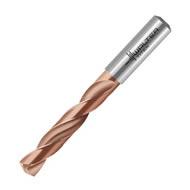

Walter Titex X-treme solid carbide high-performance drills from Walter, currently in use in a wide variety of industries including automotive, energy, die and mold and general metalworking applications are now available as non-coolant thru drills.
Like the popular internally-cooled series, these non coolant thru X-treme drills are available from 1⁄8" to ¾" (3 to 25mm) in diameter and can be used with all common materials. Like the internally cooled line, these new Walter Titex X-treme drills feature a four-margins design which improves the stability of the drills relative to the workpiece. This enables the drills to maintain position at the point of entrance or exit, and also when machining inclined surfaces.
This improvement in drill stability boosts both process reliability and productivity, even in critical drilling situations. That's because in many cases the processing time for components is reduced, as the user is able to forgo prep operations such as milling a flat surface or drilling pilot holes. The four margins also ensure an improved hole surface finish.
All drills in the Walter Titex X-treme solid carbide series boast an advanced aluminum chromium nitride-based XPL coating. In addition to the universal use of the tools for all ISO material groups, the tools also deliver enhanced tool life. Other features of this range of products include a 140 degree point angle and a cylindrical shank or whistle-notch shank according to DIN 6535. The h6 shank tolerance is suitable for shrink fit chucks. These new solid carbide high-performance drills cover the same application areas as the Alpha 2 series but provide increased performance and tool life.
Contact Details
Related Glossary Terms
- coolant
coolant
Fluid that reduces temperature buildup at the tool/workpiece interface during machining. Normally takes the form of a liquid such as soluble or chemical mixtures (semisynthetic, synthetic) but can be pressurized air or other gas. Because of water’s ability to absorb great quantities of heat, it is widely used as a coolant and vehicle for various cutting compounds, with the water-to-compound ratio varying with the machining task. See cutting fluid; semisynthetic cutting fluid; soluble-oil cutting fluid; synthetic cutting fluid.
- flat ( screw flat)
flat ( screw flat)
Flat surface machined into the shank of a cutting tool for enhanced holding of the tool.
- gang cutting ( milling)
gang cutting ( milling)
Machining with several cutters mounted on a single arbor, generally for simultaneous cutting.
- metalworking
metalworking
Any manufacturing process in which metal is processed or machined such that the workpiece is given a new shape. Broadly defined, the term includes processes such as design and layout, heat-treating, material handling and inspection.
- milling
milling
Machining operation in which metal or other material is removed by applying power to a rotating cutter. In vertical milling, the cutting tool is mounted vertically on the spindle. In horizontal milling, the cutting tool is mounted horizontally, either directly on the spindle or on an arbor. Horizontal milling is further broken down into conventional milling, where the cutter rotates opposite the direction of feed, or “up” into the workpiece; and climb milling, where the cutter rotates in the direction of feed, or “down” into the workpiece. Milling operations include plane or surface milling, endmilling, facemilling, angle milling, form milling and profiling.
- point angle
point angle
Included angle at the point of a twist drill or similar tool; for general-purpose tools, the point angle is typically 118°.
- shank
shank
Main body of a tool; the portion of a drill or similar end-held tool that fits into a collet, chuck or similar mounting device.
- tolerance
tolerance
Minimum and maximum amount a workpiece dimension is allowed to vary from a set standard and still be acceptable.

